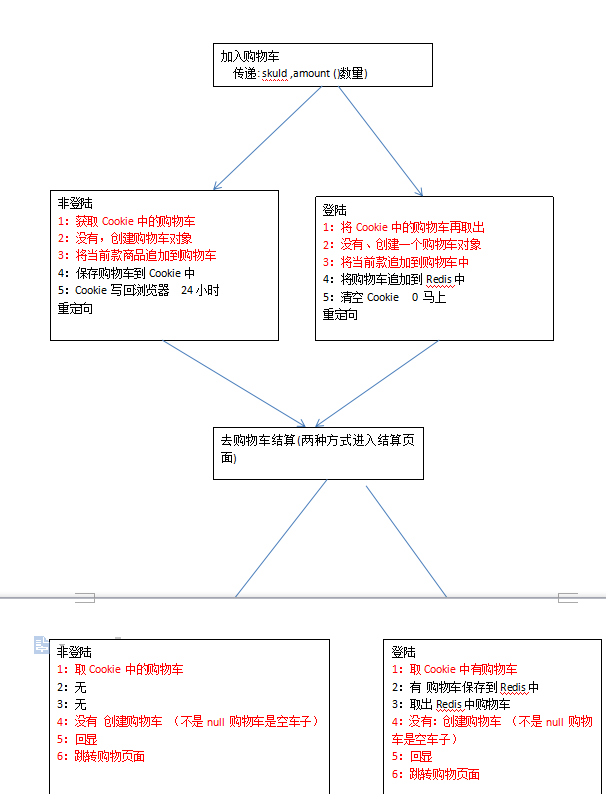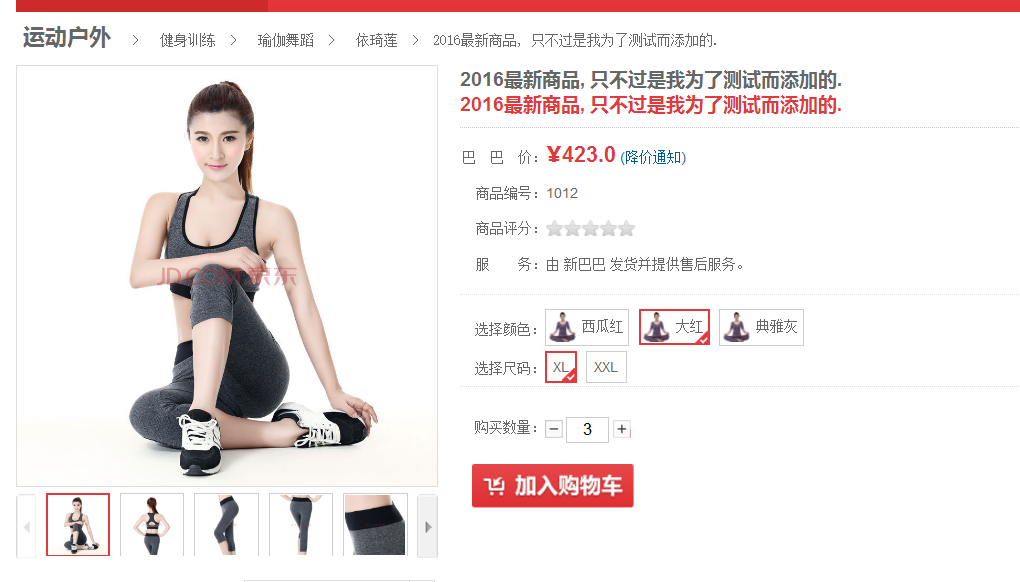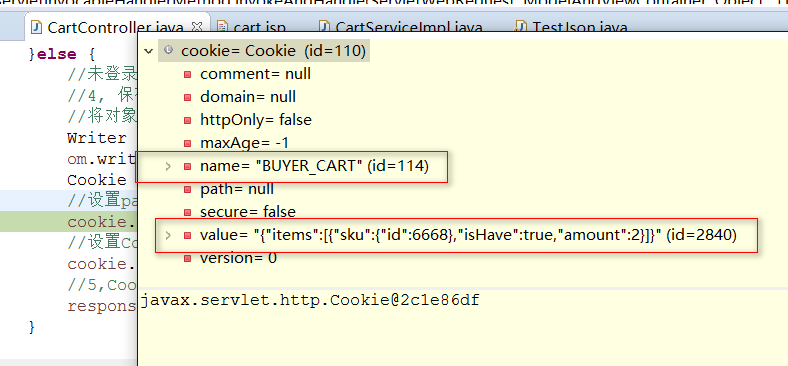京東Java架構師講解購物車的原理及Java實現
今天來寫一下關於購物車的東西, 這裡首先丟擲四個問題:
1)使用者沒登陸使用者名稱和密碼,新增商品, 關閉瀏覽器再開啟後 不登入使用者名稱和密碼 問:購物車商品還在嗎?
2)使用者登陸了使用者名稱密碼,新增商品,關閉瀏覽器再開啟後 不登入使用者名稱和密碼 問:購物車商品還在嗎?
3)使用者登陸了使用者名稱密碼,新增商品, 關閉瀏覽器,然後再開啟,登陸使用者名稱和密碼 問:購物車商品還在嗎?
4)使用者登陸了使用者名稱密碼,新增商品, 關閉瀏覽器 外地老家開啟瀏覽器 登陸使用者名稱和密碼 問:購物車商品還在嗎?
上面四個問題都是以京東為模板, 那麼大家猜猜結果是什麼呢?
1)在
2)不在了
3)在
4)在
如果你能夠猜到答案, 那麼說明你真的很棒, 那麼關於這四點是怎麼實現的呢? (如果有不認可的小夥伴可以用京東實驗一下)
下面我們就來講解下購物車的原理,最後再來說下具體的code實現.
1)使用者沒有登入, 新增商品, 此時的商品是被新增到了瀏覽器的Cookie中, 所以當再次訪問時(不登入),商品仍然在Cookie中, 所以購物車中的商品還是存在的.
2)使用者登入了,新增商品, 此時會將Cookie中和使用者選擇的商品都新增到購物車中, 然後刪除Cookie中的商品. 所以當用戶再次訪問(不登入),此時Cookie中的購物車商品已經被刪除了, 所以此時購物車中的商品不在了.
3)使用者登入, 新增商品,此時商品被新增到資料庫做了持久化儲存, 再次開啟登入使用者名稱和密碼, 該使用者選擇的商品肯定還是存在的, 所以購物車中的商品還是存在的.
4)理由3)
這裡再說下 沒登入 儲存商品到Cookie的優點以及儲存到Session和資料庫的對比:
1:Cookie: 優點: 儲存使用者瀏覽器(不用浪費我們公司的伺服器) 缺點:Cookie禁用,不提供儲存
2:Session:(Redis : 浪費大量伺服器記憶體:實現、禁用Cookie) 速度很快
3:資料庫(Mysql、Redis、SOlr) 能持久化的就資料庫 速度太慢
那麼我今天要講的就是:
使用者沒登陸:購物車新增到Cookie中
使用者登陸: 儲存購物車到Redis中 (不用資料庫)
整體的思路圖解:

接下來就是程式碼例項來實現 購物車的功能了:
首先我們看下購物車和購物項兩個JavaBean的設計:
購物車: buyerCart.java
1 public classBuyerCartimplementsSerializable{
2
3 /**
4 * 購物車
5 */
6 private static final long serialVersionUID = 1L;
7
8 //商品結果集
9 private List<BuyerItem> items = new ArrayList<BuyerItem>();
10
11 //新增購物項到購物車
12 publicvoidaddItem(BuyerItem item){
13 //判斷是否包含同款
14 if (items.contains(item)) {
15 //追加數量
16 for (BuyerItem buyerItem : items) {
17 if (buyerItem.equals(item)) {
18 buyerItem.setAmount(item.getAmount() + buyerItem.getAmount());
19 }
20 }
21 }else {
22 items.add(item);
23 }
24
25 }
26
27 public List<BuyerItem> getItems(){
28 return items;
29 }
30
31 publicvoidsetItems(List<BuyerItem> items){
32 this.items = items;
33 }
34
35
36 //小計
37 //商品數量
38 @JsonIgnore
39 public Integer getProductAmount(){
40 Integer result = 0;
41 //計算
42 for (BuyerItem buyerItem : items) {
43 result += buyerItem.getAmount();
44 }
45 return result;
46 }
47
48 //商品金額
49 @JsonIgnore
50 public Float getProductPrice(){
51 Float result = 0f;
52 //計算
53 for (BuyerItem buyerItem : items) {
54 result += buyerItem.getAmount()*buyerItem.getSku().getPrice();
55 }
56 return result;
57 }
58
59 //運費
60 @JsonIgnore
61 public Float getFee(){
62 Float result = 0f;
63 //計算
64 if (getProductPrice() < 79) {
65 result = 5f;
66 }
67
68 return result;
69 }
70
71 //總價
72 @JsonIgnore
73 public Float getTotalPrice(){
74 return getProductPrice() + getFee();
75 }
76
77 }這裡使用了@JsonIgonre註解是因為下面需要將BuyerCart 轉換成Json格式, 而這幾個欄位只有get 方法, 所以不能轉換, 需要使用忽略Json.
下面是購物項: buyerItem.java
1 public classBuyerItemimplementsSerializable{
2
3 private static final long serialVersionUID = 1L;
4
5 //SKu物件
6 private Sku sku;
7
8 //是否有貨
9 private Boolean isHave = true;
10
11 //購買的數量
12 private Integer amount = 1;
13
14 public Sku getSku(){
15 return sku;
16 }
17
18 publicvoidsetSku(Sku sku){
19 this.sku = sku;
20 }
21
22 public Boolean getIsHave(){
23 return isHave;
24 }
25
26 publicvoidsetIsHave(Boolean isHave){
27 this.isHave = isHave;
28 }
29
30 public Integer getAmount(){
31 return amount;
32 }
33
34 publicvoidsetAmount(Integer amount){
35 this.amount = amount;
36 }
37
38 @Override
39 publicinthashCode(){
40 final int prime = 31;
41 int result = 1;
42 result = prime * result + ((sku == null) ? 0 : sku.hashCode());
43 return result;
44 }
45
46 @Override
47 publicbooleanequals(Object obj){
48 if (this == obj) //比較地址
49 return true;
50 if (obj == null)
51 return false;
52 if (getClass() != obj.getClass())
53 return false;
54 BuyerItem other = (BuyerItem) obj;
55 if (sku == null) {
56 if (other.sku != null)
57 return false;
58 } else if (!sku.getId().equals(other.sku.getId()))
59 return false;
60 return true;
61 }
62 }1、將商品加入購物車中

1 //加入購物車
2 function addCart(){
3 // + skuId
4 window.location.href="/shopping/buyerCart?skuId="+skuId+"&amount="+$("#buy-num").val();
5 }這裡傳入的引數是skuId(庫存表的主鍵, 庫存表儲存的商品id,顏色,尺碼,庫存等資訊), 購買數量amount.
接著我們來看Controller是如何來處理的:
1 //加入購物車
2 @RequestMapping(value="/shopping/buyerCart")
3 public <T> String buyerCart(Long skuId, Integer amount, HttpServletRequest request,
4 HttpServletResponse response)throws JsonParseException, JsonMappingException, IOException{
5 //將物件轉換成json字串/json字串轉成物件
6 ObjectMapper om = new ObjectMapper();
7 om.setSerializationInclusion(Include.NON_NULL);
8 BuyerCart buyerCart = null;
9 //1,獲取Cookie中的購物車
10 Cookie[] cookies = request.getCookies();
11 if (null != cookies && cookies.length > 0) {
12 for (Cookie cookie : cookies) {
13 //
14 if (Constants.BUYER_CART.equals(cookie.getName())) {
15 //購物車 物件 與json字串互轉
16 buyerCart = om.readValue(cookie.getValue(), BuyerCart.class);
17 break;
18 }
19 }
20 }
21
22 //2,Cookie中沒有購物車, 建立購物車物件
23 if (null == buyerCart) {
24 buyerCart = new BuyerCart();
25 }
26
27 //3, 將當前款商品追加到購物車
28 if (null != skuId && null != amount) {
29 Sku sku = new Sku();
30 sku.setId(skuId);
31 BuyerItem buyerItem = new BuyerItem();
32 buyerItem.setSku(sku);
33 //設定數量
34 buyerItem.setAmount(amount);
35 //新增購物項到購物車
36 buyerCart.addItem(buyerItem);
37 }
38
39 //排序 倒序
40 List<BuyerItem> items = buyerCart.getItems();
41 Collections.sort(items, new Comparator<BuyerItem>() {
42
43 @Override
44 publicintcompare(BuyerItem o1, BuyerItem o2){
45 return -1;
46 }
47
48 });
49
50 //前三點 登入和非登入做的是一樣的操作, 在第四點需要判斷
51 String username = sessionProviderService.getAttributterForUsername(RequestUtils.getCSessionId(request, response));
52 if (null != username) {
53 //登入了
54 //4, 將購物車追加到Redis中
55 cartService.insertBuyerCartToRedis(buyerCart, username);
56 //5, 清空Cookie 設定存活時間為0, 立馬銷燬
57 Cookie cookie = new Cookie(Constants.BUYER_CART, null);
58 cookie.setPath("/");
59 cookie.setMaxAge(-0);
60 response.addCookie(cookie);
61 }else {
62 //未登入
63 //4, 儲存購物車到Cookie中
64 //將物件轉換成json格式
65 Writer w = new StringWriter();
66 om.writeValue(w, buyerCart);
67 Cookie cookie = new Cookie(Constants.BUYER_CART, w.toString());
68 //設定path是可以共享cookie
69 cookie.setPath("/");
70 //設定Cookie過期時間: -1 表示關閉瀏覽器失效 0: 立即失效 >0: 單位是秒, 多少秒後失效
71 cookie.setMaxAge(24*60*60);
72 //5,Cookie寫會瀏覽器
73 response.addCookie(cookie);
74 }
75
76 //6, 重定向
77 return "redirect:/shopping/toCart";
78 }這裡設計一個知識點: 將物件轉換成json字串/json字串轉成物件
我們在這裡先寫一個小的Demo來演示json和物件之間的互轉, 這裡使用到了springmvc中的ObjectMapper類.
1 public class TestJson {
2
3 @Test
4 public void testAdd() throws Exception {
5 TestTb testTb = new TestTb();
6 testTb.setName("范冰冰");
7 ObjectMapper om = new ObjectMapper();
8 om.setSerializationInclusion(Include.NON_NULL);
9 //將物件轉換成json字串
10 Writer wr = new StringWriter();
11 om.writeValue(wr, testTb);
12 System.out.println(wr.toString());
13
14 //轉回物件
15 TestTb r = om.readValue(wr.toString(), TestTb.class);
16 System.out.println(r.toString());
17 }
18
19 }執行結果:

這裡我們使用了Include.NON_NULL, 如果TestTb 中屬性為null 的就不給轉換成Json, 從物件-->Json字串 用的是 objectMapper.writeValue(). 從Json字串-->物件使用的是objectMapper.readValue().
迴歸上面我們專案中的程式碼, 只有未登入 新增商品時才會將此商品新增到Cookie中.
1 //未登入
2 //4, 儲存購物車到Cookie中
3 //將物件轉換成json格式
4 Writer w = new StringWriter();
5 om.writeValue(w, buyerCart);
6 Cookie cookie = new Cookie(Constants.BUYER_CART, w.toString());
7 //設定path是可以共享cookie
8 cookie.setPath("/");
9 //設定Cookie過期時間: -1 表示關閉瀏覽器失效 0: 立即失效 >0: 單位是秒, 多少秒後失效
10 cookie.setMaxAge(24*60*60);
11 //5,Cookie寫會瀏覽器
12 response.addCookie(cookie);我們debug 可以看到:

這裡已經將物件購物車物件buyerCart轉換成了Json格式.
將商品新增到購物車, 不管是登入還是未登入, 都要先取出Cookie中的購物車, 然後將當前選擇的商品追加到購物車中.
然後登入的話 就把Cookie中的購物車清空, 並將購物車的內容新增到Redis中做持久化儲存.
如果未登入, 將選擇的商品追加到Cookie中.
將購物車追加到Redis中的程式碼:insertBuyerCartToRedis(這裡麵包含了判斷新增的是否是同款)
1 //儲存購物車到Redis中
2 public void insertBuyerCartToRedis(BuyerCart buyerCart, String username){
3 List<BuyerItem> items = buyerCart.getItems();
4 if (items.size() > 0) {
5 //redis中儲存的是skuId 為key , amount 為value的Map集合
6 Map<String, String> hash = new HashMap<String, String>();
7 for (BuyerItem item : items) {
8 //判斷是否有同款
9 if (jedis.hexists("buyerCart:"+username, String.valueOf(item.getSku().getId()))) {
10 jedis.hincrBy("buyerCart:"+username, String.valueOf(item.getSku().getId()), item.getAmount());
11 }else {
12 hash.put(String.valueOf(item.getSku().getId()), String.valueOf(item.getAmount()));
13 }
14 }
15 if (hash.size() > 0) {
16 jedis.hmset("buyerCart:"+username, hash);
17 }
18 }
19
20 }判斷使用者是否登入: String username =
sessionProviderService.getAttributterForUsername(RequestUtils.getCSessionId(request, response));
1 public classRequestUtils{
2
3 //獲取CSessionID
4 publicstatic String getCSessionId(HttpServletRequest request, HttpServletResponse response){
5 //1, 從Request中取Cookie
6 Cookie[] cookies = request.getCookies();
7 //2, 從Cookie資料中遍歷查詢, 並取CSessionID
8 if (null != cookies && cookies.length > 0) {
9
